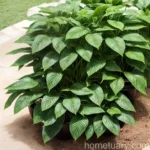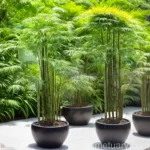The Incredible Diversity of Dwarf Fern-Leaf Bamboo (Pleioblastus pygmaeus)
In the world of plants, few evoke the grace and elegance that bamboo exhibits. Known for its versatility, strength, and beauty, bamboo has been utilized for countless purposes throughout history. From building materials to textiles and even culinary uses, bamboo has left an indelible mark across cultures worldwide.
Amidst the vast array of bamboos, the dwarf fern-leaf bamboo, scientifically known as Pleioblastus pygmaeus, stands out as a unique and fascinating variety. Its delicate and diminutive nature makes it a popular choice for those seeking a bamboo plant suitable for small spaces, indoor use, container gardening, or as an ornamental addition to their landscape.
In this extensive guide, we will delve into the world of the dwarf fern-leaf bamboo (Pleioblastus pygmaeus), exploring its origins, characteristics, cultivation, maintenance, and its potential diverse uses. Whether you are an experienced gardener, a novice plant enthusiast, or someone considering adding this graceful bamboo variety to your living space, this comprehensive resource will provide you with valuable insights and tips for successfully growing and caring for the Pleioblastus pygmaeus.
So, let’s embark on a journey to uncover the enchanting world of the dwarf fern-leaf bamboo.
What is the Dwarf Fern-Leaf Bamboo (Pleioblastus pygmaeus)?
Dwarf fern-leaf bamboo, scientifically referred to as Pleioblastus pygmaeus, is a charming and compact bamboo variety renowned for its diminutive size and delicate, fern-like foliage. Belonging to the Poaceae family, this miniature bamboo is native to the forests of Japan and other parts of Asia, where it thrives in the understory, creating lush, green carpets with its gently arching foliage.
Key Takeaways – Dwarf Fern-Leaf Bamboo (Pleioblastus pygmaeus):
- Scientific Name: Pleioblastus pygmaeus
- Common Names: Dwarf bamboo plant, fern-leaf bamboo, miniature bamboo plant, ornamental dwarf bamboo
- Growth Habit: Low-growing, compact, with fern-like bamboo leaves
- Characteristics: Ideal for small spaces, container gardening, and indoor use
- Care Requirements: Suitable for shady areas, low-maintenance, and versatile in various garden designs
Now, let’s dive deeper into various aspects of the dwarf fern-leaf bamboo, including its culture, uses, care requirements, and many more insightful details.
Culture
Understanding the culture of the Pleioblastus pygmaeus is essential for fostering its healthy growth and vibrant foliage. Cultivation practices, water requirements, sunlight preferences, and soil conditions contribute significantly to the overall well-being of this exquisite bamboo variety.
Uses
The dwarf fern-leaf bamboo (Pleioblastus pygmaeus) presents a myriad of uses, making it a versatile and sought-after plant for various gardening and landscaping endeavors. Its charming appearance and manageable size render it suitable for a wide range of applications, including:
- Indoor and container gardening
- Ornamental ground cover
- Landscape borders and edging
- Shaded garden areas
- Privacy screens
- Erosion control
- Asian-themed gardens
- Urban and small gardens
- Coastal landscapes
- Traditional and minimalist garden designs
Now, let’s explore the key factors influencing the successful cultivation and utilization of the dwarf fern-leaf bamboo.
Water
Sufficient and consistent watering is crucial for the well-being of Pleioblastus pygmaeus. While this bamboo variety appreciates moist conditions, it is vital to prevent waterlogging, as excessive moisture can lead to root rot and other detrimental issues.
To maintain optimal soil moisture for the dwarf fern-leaf bamboo:
– Watering Frequency: Water the plant regularly, ensuring the soil remains consistently moist but not waterlogged.
– Drainage Considerations: Utilize well-draining soil and containers with adequate drainage holes to prevent water stagnation.
– Established Plant Care: Once established, the dwarf bamboo demonstrates good drought tolerance, although regular watering is still recommended, especially during dry periods.
Sunlight
The Pleioblastus pygmaeus thrives in shaded to partially shaded locations, making it an ideal option for areas with limited direct sunlight. When grown indoors, placing the bamboo near a window with filtered light is beneficial. However, it is essential to shield the plant from intense sunlight to prevent leaf scorching and maintain its lush, vibrant foliage.
Guidelines for providing suitable sunlight for the dwarf fern-leaf bamboo:
– Indoor Placement: Select well-lit areas with indirect sunlight, avoiding prolonged exposure to direct sun.
– Outdoor Conditions: Choose shaded or partially shaded spots, particularly in regions with intense sunlight.
– Leaf Health: Monitor the foliage for signs of sun damage, such as browning or yellowing, and adjust the plant’s placement accordingly.
Fertilizer
Feeding the Pleioblastus pygmaeus with a balanced and suitable fertilizer can significantly enhance its growth and vitality. Selecting a fertilizer with the appropriate nutrient composition and applying it at the right time ensures that the bamboo receives essential elements for its flourishing development.
Important considerations for fertilizing the dwarf fern-leaf bamboo:
– Fertilizer Type: Utilize a balanced, slow-release fertilizer formulated for ornamental grasses or bamboo plants.
– Application Frequency: Feed the bamboo during the growing season, typically in spring and summer, following the product’s instructions for dilution and application rates.
– Avoid Overfertilization: Refrain from excessive fertilization, as it can lead to undesirable vigorous growth and potential nutrient imbalances.
Soil
The choice of soil is pivotal in providing an optimal growing environment for the dwarf fern-leaf bamboo. Well-draining, fertile soil with adequate organic matter serves as a foundation for the bamboo’s robust growth and overall health.
Critical aspects of the ideal soil conditions for Pleioblastus pygmaeus include:
– Drainage and Aeration: Select soil that offers excellent drainage, preventing waterlogging and potential root issues.
– Organic Matter Content: Incorporate compost or organic matter to enhance soil fertility and structure, promoting healthier root development.
– pH Levels: Aim for slightly acidic to neutral soil pH, typically in the range of 5.5 to 7.0, which is suitable for most ornamental plants, including bamboo.
Pruning
Effective pruning contributes to the maintenance of the Pleioblastus pygmaeus’ compact and graceful appearance. Proper pruning practices aid in managing the bamboo’s growth, removing damaged or unsightly foliage, and shaping the plant as desired.
Propagation
The propagation of the dwarf fern-leaf bamboo (Pleioblastus pygmaeus) offers opportunities to multiply and expand its presence in various settings. Understanding the propagation techniques specific to bamboo plants is essential for successfully cultivating new specimens.
Methods for propagating Pleioblastus pygmaeus may include:
– Division: Divide established clumps of bamboo, ensuring that each division possesses viable rhizomes and adequate foliage for successful establishment.
– Rhizome Cuttings: Collect healthy rhizome cuttings and propagate them in suitable growing conditions, fostering the development of new bamboo plants.
Container Popularity
The dwarf fern-leaf bamboo’s compact size and graceful demeanor make it an attractive choice for container gardening. Its adaptability to container culture enables individuals with limited outdoor space to enjoy the beauty and elegance of bamboo within a confined environment.
Advantages of growing Pleioblastus pygmaeus in containers include:
– Space Efficiency: Ideal for small gardens, patios, balconies, and urban settings with limited space.
– Versatility: Offers flexibility in placement and mobility, allowing for easy relocation as needed.
– Indoor Use: Suitable for indoor cultivation, adding a touch of nature to interior spaces with its lush greenery.
Common Diseases
While the dwarf fern-leaf bamboo (Pleioblastus pygmaeus) is generally resilient, it is susceptible to certain diseases that can affect its vigor and appearance. Recognizing these potential ailments and implementing preventive measures is crucial for cultivating healthy and flourishing bamboo plants.
Common diseases that may impact the Pleioblastus pygmaeus include:
– Root Rot: Caused by waterlogged conditions and poorly draining soil, leading to the decay of the plant’s root system.
– Fungal Infections: Various fungal pathogens can affect bamboo, leading to leaf spot diseases and other foliar issues.
– Bamboo Mosaic Virus: A viral infection that can manifest as leaf mottling, stunted growth, and overall decline in plant health.
Disease Diagnosis
Early detection and prompt diagnosis of potential diseases are pivotal in implementing effective management strategies and safeguarding the well-being of the dwarf fern-leaf bamboo. Monitoring the plant for symptoms of diseases, conducting regular inspections, and taking proactive measures are essential for disease control and prevention.
Indications of possible diseases affecting Pleioblastus pygmaeus:
– Yellowing or Browning Foliage: Signifying potential fungal infections, nutrient deficiencies, or water-related issues.
– Stunted Growth: Indicates underlying problems, such as root rot or viral infections, affecting the plant’s overall vitality.
– Leaf Abnormalities: Including spots, lesions, or unusual patterns, which may point to specific disease issues requiring attention.
Common Pests
Although generally resilient, the dwarf fern-leaf bamboo (Pleioblastus pygmaeus) can encounter pest-related challenges, necessitating vigilance and proactive pest management measures. Some common pests that may affect bamboo include:
- Aphids: Small, sap-feeding insects that can cluster on tender shoot tips and foliage, potentially causing distortion and damage.
- Spider Mites: Minuscule pests that can infest bamboo plants, leading to stippled and discolored foliage as a result of their feeding activity.
Employing preventive measures, such as regular inspections, maintaining plant health, and considering natural predator populations, can assist in managing potential pest issues proactively.
Botanist’s Tips
Harnessing the expertise and insights of seasoned botanists can provide invaluable guidance and recommendations for successfully growing and caring for the Pleioblastus pygmaeus. Botanical experts offer practical tips, in-depth knowledge, and comprehensive perspectives on cultivating and appreciating this exquisite bamboo species.
Important Considerations for Optimal Pleioblastus pygmaeus Care:
- Selecting Suitable Varieties: Explore different Pleioblastus pygmaeus varieties to discover unique characteristics and potential adaptations to specific growing conditions and uses.
- Cultivation Techniques: Implement proper planting methods, irrigation practices, and soil management to establish healthy and robust bamboo specimens.
- Observational Skills: Develop the ability to observe and interpret the plant’s growth patterns, response to environmental factors, and overall health cues.
Leveraging the wisdom and expertise of botanists and horticulturists can contribute significantly to the successful cultivation and appreciation of the dwarf fern-leaf bamboo as a captivating and versatile plant.
Fun Facts
Delight in discovering captivating and interesting facts about the dwarf fern-leaf bamboo (Pleioblastus pygmaeus), enriching your appreciation for this remarkable bamboo variety.
Entertaining Tidbits about Pleioblastus pygmaeus:
- Bamboo Symbolism: Bamboo is revered in various cultures as a symbol of resilience, longevity, and strength, encapsulating its profound cultural significance.
- Versatile Uses: Bamboo has been utilized for diverse purposes, including construction, art and crafts, culinary applications, and musical instruments, showcasing its remarkable versatility.
- Growth Rate: The Pleioblastus pygmaeus exhibits a moderate growth rate, gradually forming dense clumps adorned with delicate, fern-like foliage, adding a touch of elegance to its surroundings.
By uncovering these engaging facts, you can further appreciate the unique allure and rich heritage of the dwarf fern-leaf bamboo.
Links to External Resources
For those seeking additional information, resources, and insights on the dwarf fern-leaf bamboo (Pleioblastus pygmaeus) and related topics, the following external links offer valuable perspectives and knowledge:
- Royal Horticultural Society (RHS) – Bamboo
- Missouri Botanical Garden – Pleioblastus pygmaeus
- American Bamboo Society
- The Plant List – Pleioblastus pygmaeus
- University of Florida IFAS Extension – Bamboo for Small Gardens
These reputable sources offer a wealth of information on bamboo plants, cultivation practices, and complementary gardening topics, enriching your botanical knowledge and guiding your pursuit of nurturing and celebrating the beauty of Pleioblastus pygmaeus.
In conclusion, the dwarf fern-leaf bamboo (Pleioblastus pygmaeus) captivates with its graceful charm, compact form, and versatile uses, making it an exceptional addition to diverse garden settings and living spaces. Armed with a deeper understanding of its cultural requirements, potential uses, and essential care considerations, you are well-equipped to embark on your journey of cultivating and appreciating the remarkable Pleioblastus pygmaeus, enriching your botanical pursuits and nurturing a connection with nature’s splendid diversity.















